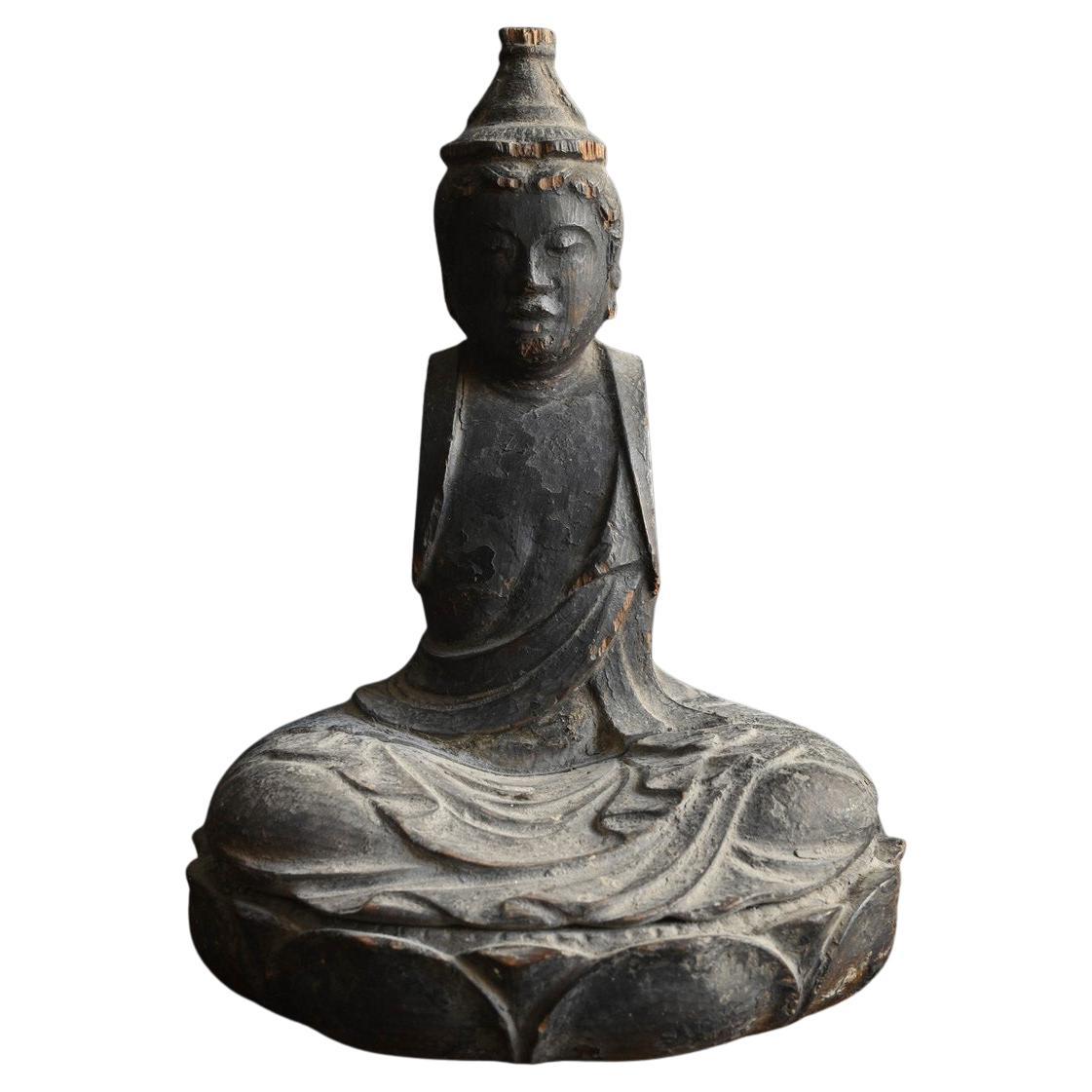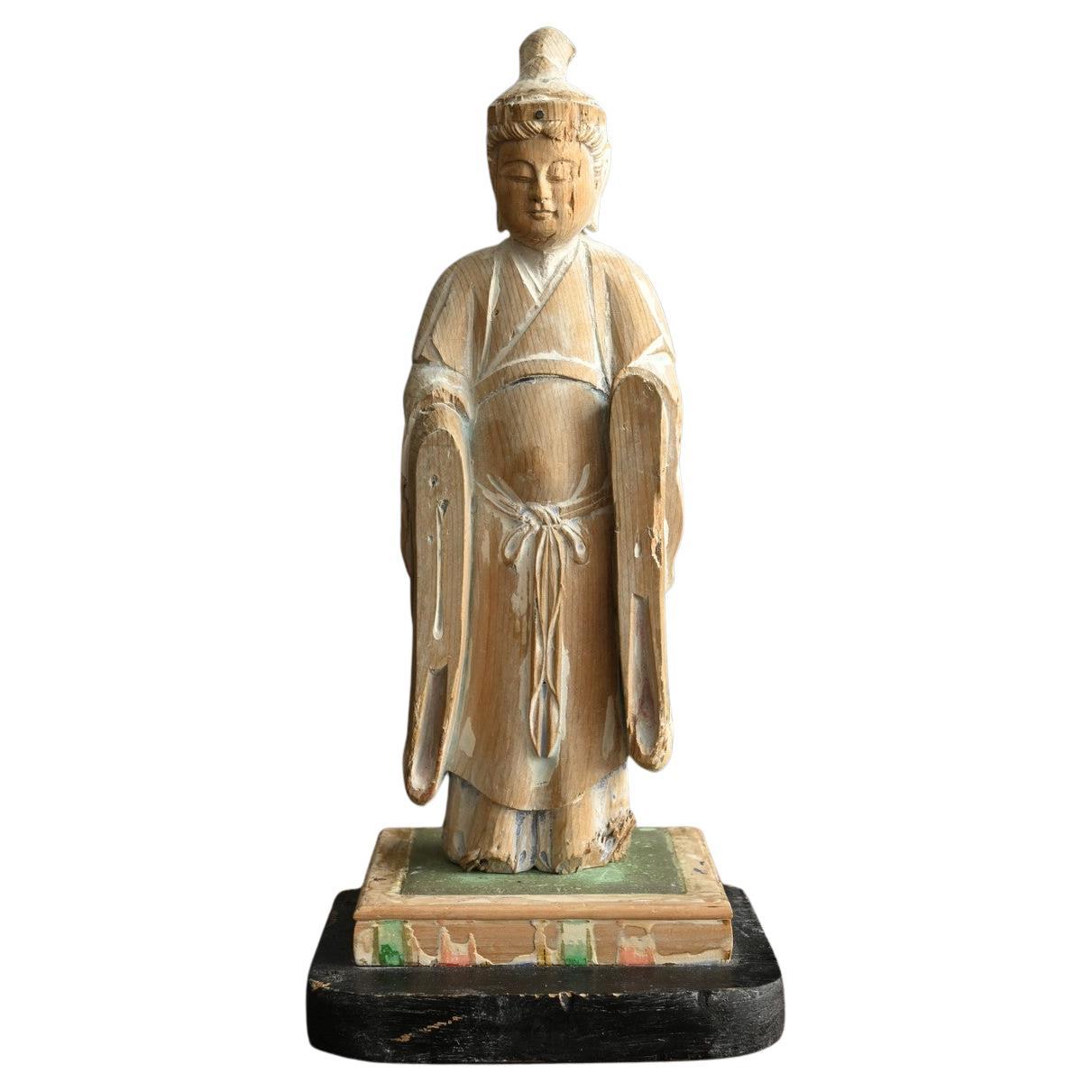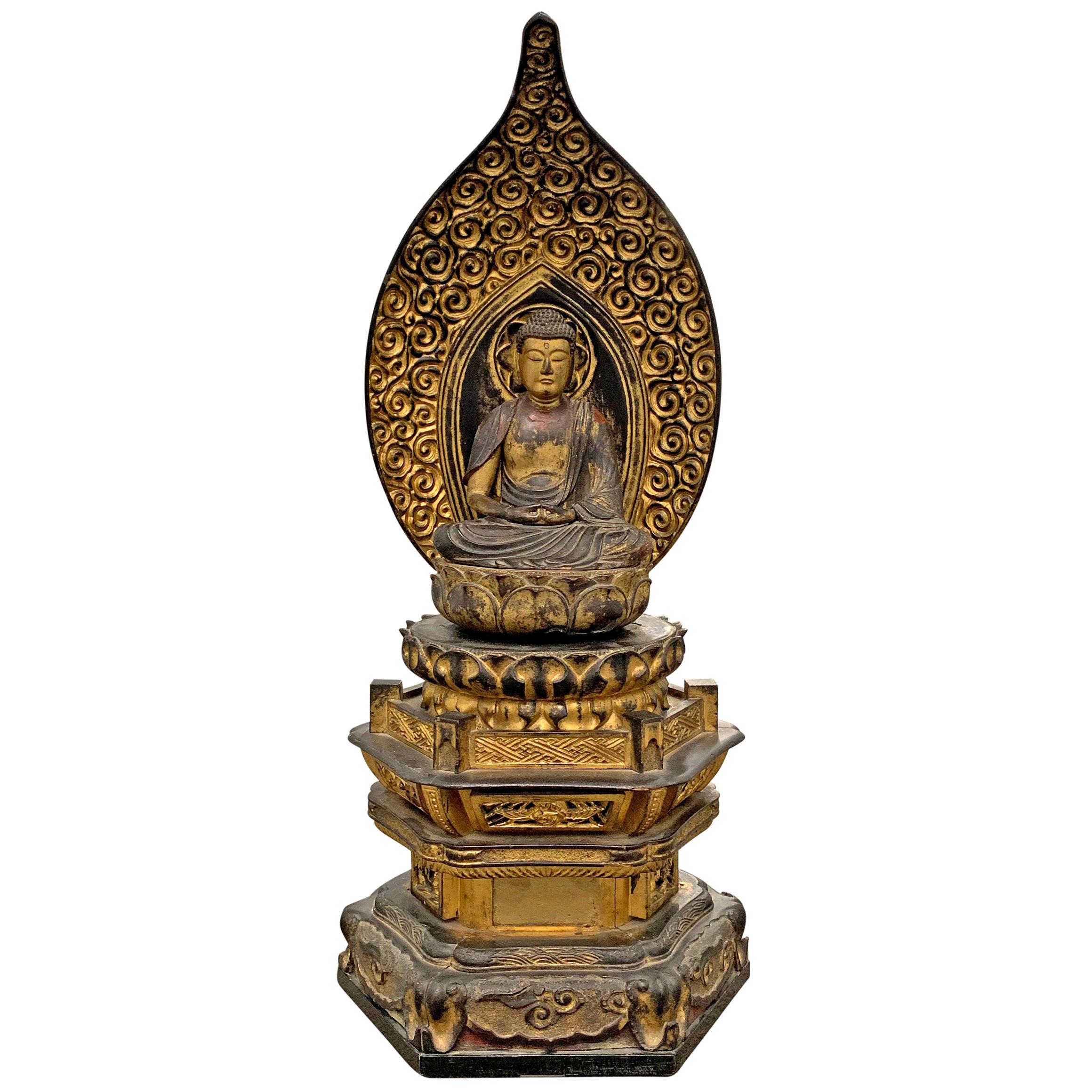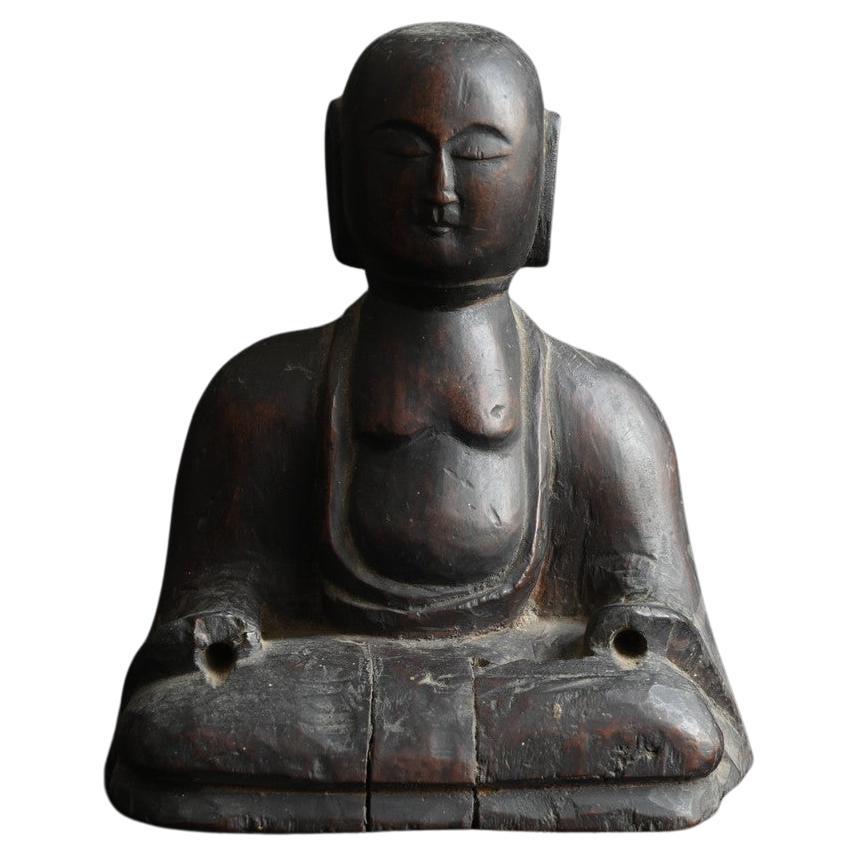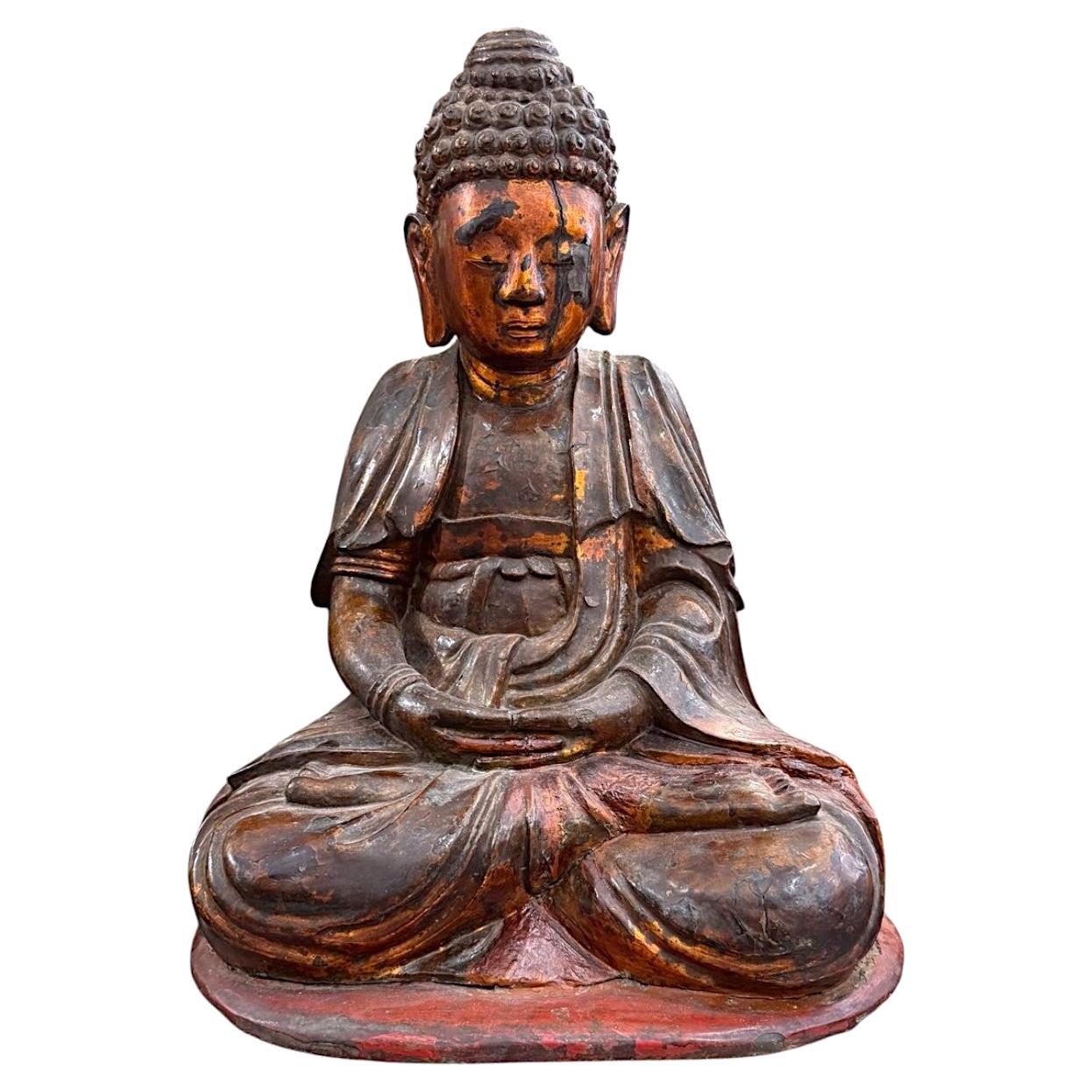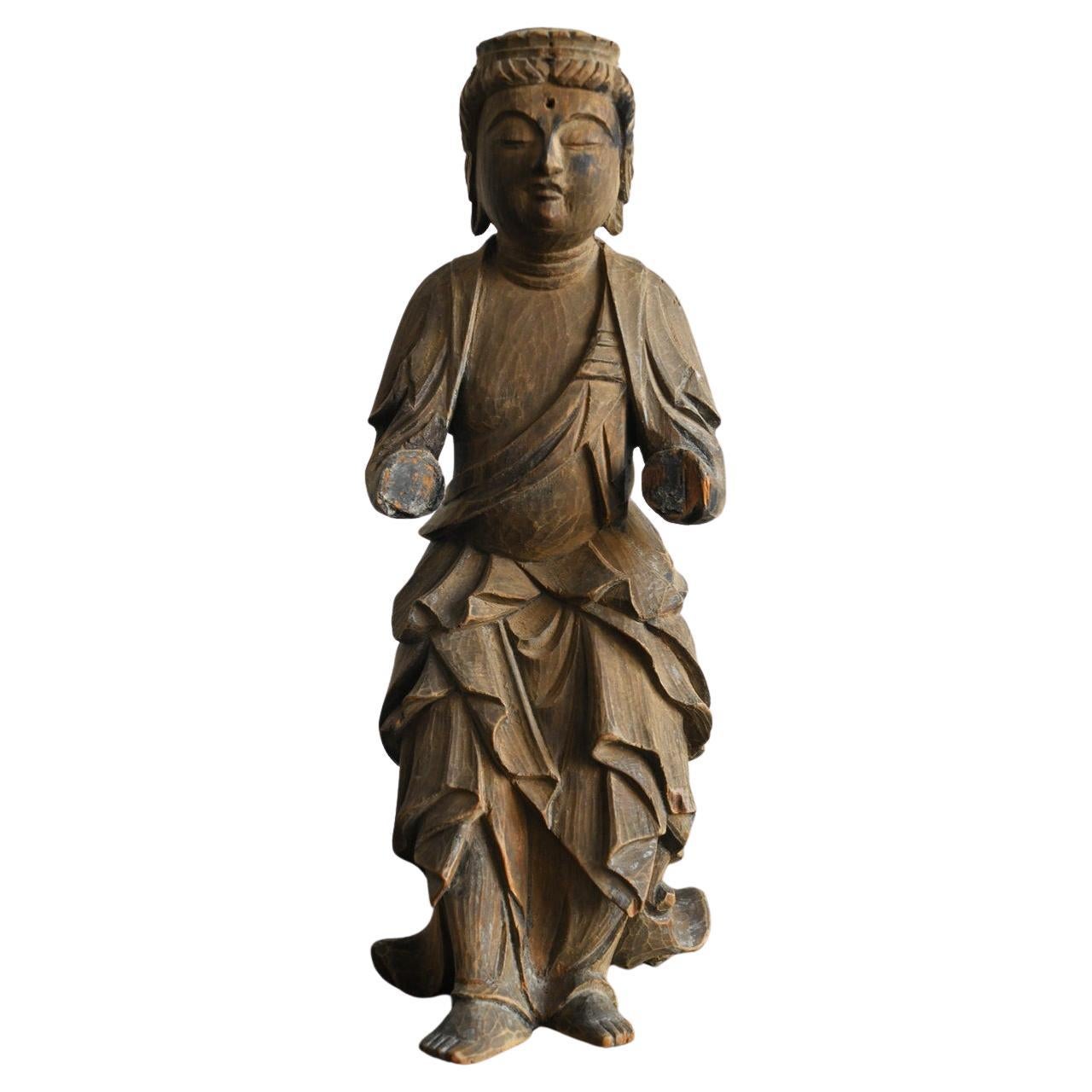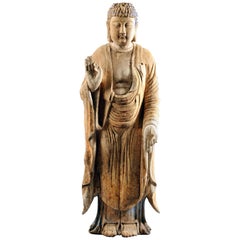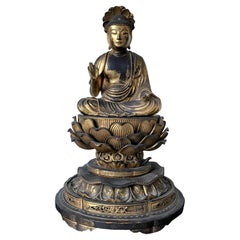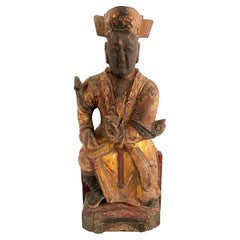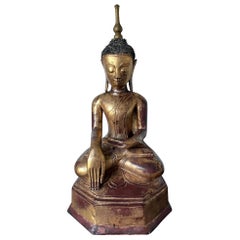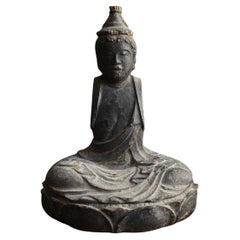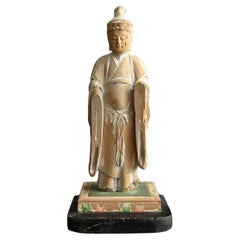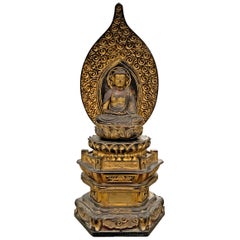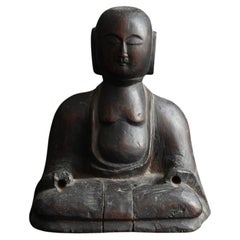Items Similar to Antique Japanese Carved Village Buddha Enku Style
Want more images or videos?
Request additional images or videos from the seller
1 of 17
Antique Japanese Carved Village Buddha Enku Style
$1,600
£1,214.04
€1,388.15
CA$2,234.77
A$2,484.76
CHF 1,297.40
MX$30,245.53
NOK 16,554.29
SEK 15,510.58
DKK 10,360.02
Shipping
Retrieving quote...The 1stDibs Promise:
Authenticity Guarantee,
Money-Back Guarantee,
24-Hour Cancellation
About the Item
A carved wood buddha with lacquered surface in the style of Erku (1632–1695), a monk from Edo period who was famous for hand-carving Buddha statues in a primitive style. From a single wood block of what appears to be cedar, the standing buddha was carved in an unpolished manner with exposed knife strokes that effectively depicted a subtly smiling face and the folding of the cascading robes. The rustic style is full of Mingei charm being a great example of Japanese Buddhism folk art. The buddha stands on his original scalloped pedestal (part of the buddha statue), which has an unfinished lower part that was installed on altar and alcove for worship. The buddha has his right hand raised in abhaya mudra (the hand gesture of "having no fear") and his left hand in varada mudra (the hand gesture of "wishes are granted"). The face and the body of the buddha was lacquered in an earthy red while the robe in black. The statue is displayed on a tiered wood stand (not fixed) from a later period. The statue itself is 19" in height.
The buddha statue displays lots of aged patina, indicating a history of extensive use. His right hand is now lost and there are numerous old crack lines and losses throughout the piece. Buddha of such age and style was worshipped historically in rural area of Japan and were quite different from the ones in the temples for its rough and unadorned aesthetic.
- Dimensions:Height: 25 in (63.5 cm)Width: 12 in (30.48 cm)Depth: 4.25 in (10.8 cm)
- Style:Edo (Of the Period)
- Materials and Techniques:
- Place of Origin:
- Period:
- Date of Manufacture:18th Century
- Condition:Wear consistent with age and use. Minor losses. Lots of patina as shown, aged crack lines, wormholes etc. Wood stand was from a later period.
- Seller Location:Atlanta, GA
- Reference Number:1stDibs: LU945036848882
About the Seller
4.9
Platinum Seller
Premium sellers with a 4.7+ rating and 24-hour response times
Established in 2006
1stDibs seller since 2010
564 sales on 1stDibs
Typical response time: <1 hour
- ShippingRetrieving quote...Shipping from: Atlanta, GA
- Return Policy
Authenticity Guarantee
In the unlikely event there’s an issue with an item’s authenticity, contact us within 1 year for a full refund. DetailsMoney-Back Guarantee
If your item is not as described, is damaged in transit, or does not arrive, contact us within 7 days for a full refund. Details24-Hour Cancellation
You have a 24-hour grace period in which to reconsider your purchase, with no questions asked.Vetted Professional Sellers
Our world-class sellers must adhere to strict standards for service and quality, maintaining the integrity of our listings.Price-Match Guarantee
If you find that a seller listed the same item for a lower price elsewhere, we’ll match it.Trusted Global Delivery
Our best-in-class carrier network provides specialized shipping options worldwide, including custom delivery.More From This Seller
View AllChinese Carved Wood Teaching Buddha in Ming Style
Located in Atlanta, GA
A statue of standing Buddha (Shakyamuni), finely carved out a single block of wood (might be cypress based on the wood grains). Attired in a flowing robe with open chest, the Buddha ...
Category
Antique 19th Century Chinese Ming Sculptures and Carvings
Materials
Wood
Japanese Antique Gilt Wood Amitabha Buddha on Loctus Throne Statue
Located in Atlanta, GA
A Japanese carved wood Amitabha (Amida) Buddha statue with residual gold leafed surface circa 19th century (late Edo period). The buddha is seated in the padmasana position on an elevated double lotus throne, under a small lotus halo canopy. His right hand is held in abhaya mudra which means fearlessness in Sanskrit. The mudra symbolizes protection, peace, and fearless. His left hand gently resting on his thigh. Dressed in a flowing robe with open chest, the statue showcases a classic iconography found prominently in Japanese Buddhism art during Edo to Meiji period, characterized by the double lotus throne and a particularly serene meditative facial expression, highlighted by inset gemstones...
Category
Antique 19th Century Japanese Edo Sculptures and Carvings
Materials
Gold Leaf
19th Century Chinese Carved Wooden Altar God
Located in Atlanta, GA
This Chinese carved seated altar god was once used on the family altar to honor their ancestors. Ancestor worship plays a major role in Chinese religion. This beautifully carved figure is rich with character from a century of use with wonder signs of wear. The darken patina is created through years of burning of incense with the original gold gilt painting...
Category
Antique Early 19th Century Chinese Sculptures and Carvings
Materials
Wood, Paint
Large Lacquered Wood Antique Burmese Buddha Statue
Located in Atlanta, GA
A gilt and lacquered wood Buddha statue from Southeast Asia likely Burma, circa 19th century. The Buddha is depicted as seating on a slightly taper...
Category
Antique 19th Century Burmese Other Sculptures and Carvings
Materials
Wood, Lacquer
Antique Lopburi Buddha Statue from Thailand
Located in Atlanta, GA
The Buddha statue was made from a copper alloy in a standing position with hands in double Abhaya mudra. This mudra symbolizes the act of dispelling fear in the face of adversity. In Laos and Thailand where this mudra are used as one of the most iconic gestures, with its origin was pre-Buddhism era, when it was a symbol of good intentions and friendship when approaching strangers. In contrast to Indian iconography, it was often shown with both hands raised to the level of the shoulder in Southeast Asia. The statue was made in the classic Lopburi style, which historically was heavily influenced by Khmer art...
Category
Antique Late 18th Century Thai Other Sculptures and Carvings
Materials
Metal
Japanese Lacquered and Gilt Wood Buddhism Statue from Edo Period
Located in Atlanta, GA
An exceptional and wood statue of Buddhism Guardian Seitaka Doji from Japan circa Edo period (1603-1868), likely the earlier part of 17th century. One of two chief attendants of Fudou Myouou (the other being Kongara Doji), the name of Seitaka Doji is a transliteration of Sanskrit "Cetaka", meaning servant, slave, and he is said to personify expedient action. He is most commonly found on the right side of Fudou, together with Kongara Doji on the left, forming the Immovable triad, Fudou Sanzon, the terror of evil doers. Seitaka largely adheres to the iconography of a wrathful youth with fleshy body and face, skin in the color of a red lotus, has his hair tied in five knots, and holds a vajra in his left hand and a vajra-club in his right hand, but the actual artistic representations of him in Japan do...
Category
Antique 17th Century Japanese Japonisme Sculptures and Carvings
Materials
Metal
You May Also Like
Japanese antique wooden Buddha statue / Edo period / 1600 to 1800
Located in Sammu-shi, Chiba
This wooden statue is a relic from Japan's Edo period, and within it lies a deep history that transcends time. Originally, it was part of a more intricate statue, likely adorned with...
Category
Antique 17th Century Japanese Edo Sculptures and Carvings
Materials
Cypress
Wooden Buddha statues from the Edo period in Japan/1800-1868/Late Edo period
Located in Sammu-shi, Chiba
This wooden Buddhist statue was made in the late to late Edo period.
It is thought to be a statue of Kannon Bodhisattva.
It was originally placed in a shrine and was painted, but the...
Category
Antique 19th Century Japanese Edo Sculptures and Carvings
Materials
Cypress
Edo Period Japanese Bodhisattva Shrine
Located in Chicago, IL
An incredible Edo Period Japanese gilt and lacquered carved wood shrine depicting a Bodhisattva with piercing glass eyes, a contemplative expression, and h...
Category
Antique Early 1800s Japanese Japonisme Sculptures and Carvings
Materials
Giltwood, Lacquer, Wood
$13,125 Sale Price
25% Off
Japanese antique wood carved Buddha/1800s/late Edo period/folk Buddha
Located in Sammu-shi, Chiba
This is a wooden Jizo Bodhisattva statue made in the late Edo period in Japan.
It is thought that they were not carved by Buddhist sculptors living in central cities such as Kyoto or...
Category
Antique 19th Century Japanese Edo Figurative Sculptures
Materials
Cypress
Edo Period Vietnamese Seated Buddha Sculpture, 19th Century
Located in NICE, FR
A serene and evocative seated Vietnamese Buddha sculpture. Expertly hand-carved from wood, this statue captures the timeless grace and spiritual depth of Buddhist iconography. The Bu...
Category
Antique Late 19th Century Vietnamese Edo Sculptures and Carvings
Materials
Wood
Small wooden Buddha statue from the Edo period in Japan/17th to 19th century
Located in Sammu-shi, Chiba
We are pleased to present a small wood carving of a flanking Bodhisattva made around the Edo period.
This work is thought to be one of the Kannon ...
Category
Antique 18th Century Japanese Edo Figurative Sculptures
Materials
Cypress
More Ways To Browse
Antique Wood Block
Japanese Charm
Japanese Rustic
Japanese Wood Block
Primitive Japanese
Antique Alcove
Red Buddha
Red Lacquer Carving
Lacquered Buddha
Carved Monk
Asian Carved Wood Statue
Black Buddha Sculpture
Japanese Temple Sculpture
Antique Japanese Statues
Carved Wood Statues
Japanese Buddha Sculpture
Knife Display
Knife Blocks
